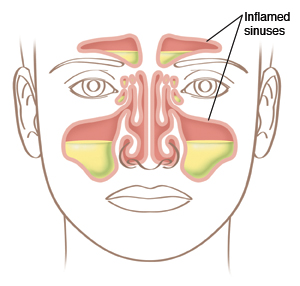The sinuses are air-filled spaces within the bones of the face. They connect to the inside of the nose. Sinusitis is an inflammation of the tissue that lines the sinuses. Sinusitis can occur during a cold. It can also happen due to seasonal allergies to pollens, and other irritants in the air. Sinusitis can cause symptoms of sinus congestion and a feeling of fullness. A sinus infection causes fever, headache, facial pain, and stuffy or runny nose. There is often green or yellow fluid draining from the nose or into the back of the throat (postnasal drip). You have been given antibiotics to treat this condition.
Home care
The treatment should focus on modulating triggers, reducing inflammation, and eradicating the infection.
-
Take the full course of antibiotics as instructed. Don't stop taking them, even when you feel better.
-
Drink plenty of water, hot tea, and other liquids as directed by the health care provider. This may help thin nasal mucus. It also may help your sinuses drain fluids.
-
Heat may help soothe painful areas of your face. Use a towel soaked in hot water. Or stand in the shower and direct the warm spray onto your face. Using a vaporizer along with a menthol rub at night may also help soothe symptoms.
-
An expectorant with guaifenesin may help thin nasal mucus and help your sinuses drain fluids. Talk with your provider or pharmacists before taking an over-the-counter (OTC) medicine if you have any questions about it or its side effects.
-
You can use an OTC decongestant, unless a similar medicine was prescribed to you. Nasal sprays work the fastest. Use one that contains phenylephrine or oxymetazoline. First blow your nose gently. Then use the spray. Don't use these medicines more often than directed on the label. If you do, your symptoms may get worse. Instead you may take pills that contain pseudoephedrine. Don’t use products that combine multiple medicines. This is because side effects may be increased. Read labels. You can also ask the pharmacist for help. (People with high blood pressure or heart disease should not use decongestants. They can raise blood pressure or cause abnormal heart rhythms.) Talk with your provider or pharmacist before taking them if you have any medical conditions.
-
OTC antihistamines may help if allergies caused your sinusitis. Talk with your provider or pharmacist if you have any questions about the medicine.
-
Ask your provider about the use of intranasal steroids. They decrease the swelling, which may help relieve the obstruction. They tend to work better if allergies are causing the sinus inflammation.
-
Nasal rinses or irrigation may help to soothe your symptoms. It's very important to use these products only as directed. Use sterile water or sterile saline solution and not tap water. Tap water may contain germs that can cause infection in the brain. Don't rinse with excess pressure. This may spread the infection to other areas in your sinuses or head. Always clean your nasal irrigation devices before and after use. Ask your health care provider or pharmacist if you have questions about using these products.
-
Use acetaminophen, naproxen, or ibuprofen to control pain, unless another pain medicine was prescribed to you. Talk with your provider before using these medicines if you take aspirin or another blood thinner, have chronic liver or kidney disease, or ever had a stomach ulcer. Never give aspirin to anyone under age 18 without first talking to their provider. It is associated with Reye's syndrome. This can cause severe liver damage.
-
Don't smoke. This can make symptoms worse.
-
Use a humidifier to moisten the air at home. Clean it regularly according to the directions.
Follow-up care
Follow up with your health care provider as advised.
When to get medical advice
Contact your health care provider if you have:
-
Facial pain or headache that gets worse.
-
Symptoms don't go away in 10 days.
-
A fever of 100.4ºF (38ºC) or higher, or as directed by your health care provider.
Call 911
Call
-
A seizure.
-
Trouble breathing.
-
Dizziness or you faint.
-
Fingernails, skin, or lips that look blue, purple, or gray.
-
A severe headache that doesn't go away.
-
A stiff neck.
-
Unusual drowsiness or confusion.
-
Vision problems, such as blurred or double vision.
-
Swelling of your forehead or eyelids.
Prevention
Here are steps you can take to help prevent an infection:
-
Keep good hand washing habits.
-
Don’t have close contact with people who have sore throats, colds, or other upper respiratory infections.
-
Don’t smoke, and stay away from secondhand smoke.
-
Stay up to date with all of your vaccines.


